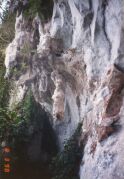

Bukit Kechil, Perlis
The occurence, properties and use of limestone.
modified from Harry W. Short
National Drillers Buyers Guide - Jan 97
Limestone is a common sedimentary rock which has a wide area extent and great vertical thickness in many regions of the world. It is one of the most abundant carbonate rocks and the principal ingredient used to manufacture cement. Other rocks similar in composition to limestone include: dolomite, travertine, calcareous tufa, onyx, marble, caliche, chalk and marl. Limestone is composed of two carbonate minerals, calcite CaCO3 and dolomite CA, Mg. Dolomite often has a flesh, pink colour indicating the presence of magnesium which chemically distinguishes it from calcite. Both minerals crystallize in the rhombohedral system but differ slighty in shape.

An outcrop at Felda in Johor??
Acids like HCl reacts actively with CaCO3 . Do try to experiment with the battery water on the limestone ........ tell me if it works, ok?
-ahchong-

A common feature in Gua Kelam, Perlis

Calcite crystals
Calcite crystals are perfectly formed, whereas dolomite crystals are curved or warped. Pure limestone is white or cream-coloured but varies when impurities are present. The most common colour is light to dark gray but can be yellow or brown from iron oxides or shades or gray and black from organic matter. The specific gravity of limestone ranges from 2.0 to 2.7 depending on the amount of impurities present and the degree of weathering or alteration. Intermediate varieties are often called dolomitic or calcitic limestone. Bioclastic limestone is a variety that is composed of loosely cemented sea shells. Limestone containing a high percentage of clay is called argillaceous limestone and that, with a high quartz sand content, is referred to as arenaceous limestone. Lithographic stone is a very fine-grained limestone that is used, as the name implies, in the lithographic industry.

Dolomite crystals
Limestone has four principal modes of origin:
1) Slow accumulation of sea shells that are cemented in situ by calcium carbonate
2) Transportation and deposition of carbonaceous materials carried by ground water solutions;
3) Direct chemical precipitation of calcium carbonate by sea water; and
4) Chemically altered or weathered carbonate products from any of formational modes.

Dolostone at Kang Giap Quarry, Bukit Bintang, Perlis

Stalaktites / overhang on the limestone wall

Onyx / Banded calcite
Travertine is pure limestone which accumulates around hot springs like those in Yellow Stone National Park. Another world famous deposit is located near Rome, Italy, which the Romans used 2,000 years ago to decorate building walls. Tufa or calcareous tufa, sometimes called sinter, is a porous limestone that forms in desert lakes, shallow bays, and springs. As calcium carbonate settles out of solution, aragonite may turn into calcite with futher chemical action. Onyx is a banded and/or mottled form of travertine that's deposited around cold springs. It takes a high polish, and is used in ornamental and lapidary work. Most onyx is imported form Mexico and is calles Mexican Onyx. Marble is metamorphic rock where calcium carbonate from the original limestones has been transformed by heat and pressure into dolomite. It is strong, compact ans has been used for centuries for making statues, tombstones, and as decorative stone on floors and walls. American marble form various locations was used in the construction of the Lincoln white, but is often discoloured by impurities like silica, iron oxide and graphite.

Bukit Kalong, Kedah

Limestone hill on calcareous chert-bearing strata, Bukit Kechil

Typical morphology on a limestone wall
It wasn't until 1842 that Joseph Aspdin, a bricklayer form Leeds, England had been powdered under the wheels of heavy carts and added varying amounts of clay to the powdered limestone. He experimented until he found the proper proportions of ingredients, which could be ground into cement after burning. Initially, the United States imported portland cement from Europe. Manufacture of portland cement began in America in 1870's, and by 1980 U.S. limestone beds produced about 10 million barrels of cement. By 1900, U.S production of cement passed the production of all natural cements and now portland cement accounts for most of the world's output of cement.
Limestone, mixed with clay which contains silica, is the most imortant material form whcih porland cement is made. Chalk or marl is sometimes used in place of limestone and shale, or slate in place of clay. Blast furnace slag sontaining both calcium and silica, can be substituted. Portland cement, whwn mixed with proper amounts of gravel, sand and water, hydrates and forms concrete, It's estimated that over half of all portland cement is produced by the dry process in the U.S. Five types of portland cement are manufactured in the United States.
Type I is used in general construction and the concrete is tested at intervals to assure that the design strength has been reached.
Type II resists moderate exposures to sulfate-bearing waters.
Type III, a higly early strength cement, gains enough strength for use soon after it is placed.
Type IV generated only a small amount of hydration heat and is used for massive concrete pours.
Type V has a very resistance to sulfate-bearing water. Air entrained cement is a mixture containing soap-like resinous, or fatty materials which form billions of microscopic air bubbles per cubic foot of mix. The bubbles relieve internal pressures that provide room for the expansion of water when it is poured under freezing conditions. Air entrained concrete has a high resistance to corrosive action form salt used in cold climates to melt snow and
ice.

Gua Musang, Kelantan